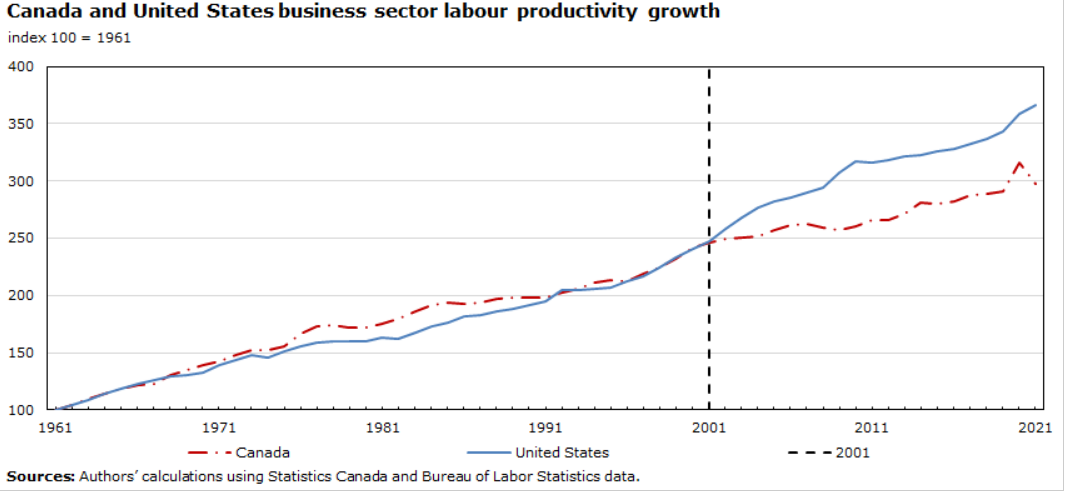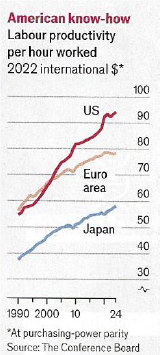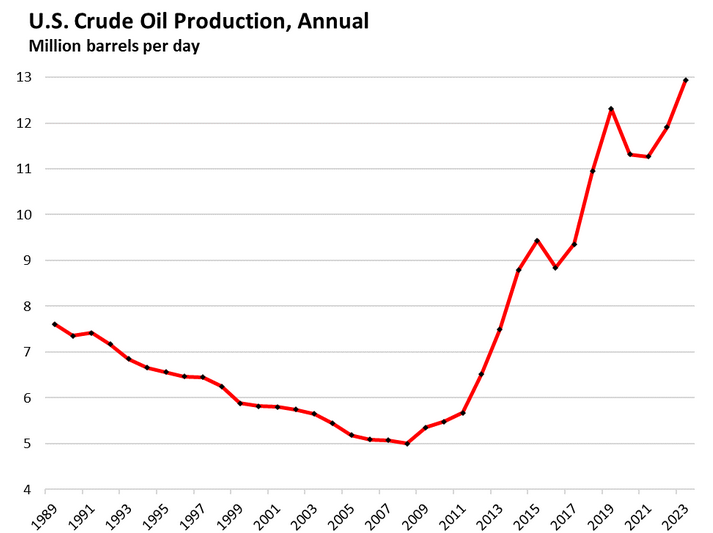Exploring the ingredients in the secret sauce of U.S. productivity
 Peter Josty is Executive Director of The Centre for Innovation Studies, based in Calgary.
Peter Josty is Executive Director of The Centre for Innovation Studies, based in Calgary.
Canada’s productivity has declined relative to the U.S. such that a Canadian worker now produces just 50 percent of what a U.S. worker does.
However, since World War II productivity has actually been quite similar between the two countries, as shown in the graphic below. What we might call a Great Divergence happened starting in 2001. What caused this? And what happened in 2001?

Source: Statistics Canada
The first thing to say is this is not just a Canadian phenomenon. U.S. growth in productivity has surpassed all Euro area countries and Japan, as shown in the graph below.
 Source: The Economist, Oct 19,2024
Source: The Economist, Oct 19,2024
So, we can re-frame the question: Why has the U.S. productivity grown so much faster than Canada and other G7 countries?
I suggest that there are three factors to explain this that are unique to the U.S.: oil production, the Magnificent 7, and offshoring. Let’s examine them.
Oil production
Since 2007, U.S. oil production has increased by 13 million barrels a day, more than two-and-a- half times 2007 production, as shown in the graphic below. This has had a huge effect on the U.S. economy.
Because oil production is one of the most productive sectors of the economy, it has raised productivity considerably. Also, as Bloomberg reports, oil and gas extraction has seen the fastest labour productivity gains of any sector in the past decade.

Source: EIA and Wolfstreet.com
Texas and Alberta have an almost identical GDP per capita ($US84,000 for Texas, $US82,200 for Alberta) because both have large oil and gas deposits.
The origins of the rise in U.S. oil production can be traced to the 1990s. Fracking (hydraulic fracturing) had been in use for a long time in the U.S., to extract oil and natural gas from tight shale formations.
However, during the 1990s and early 2000s, the technology was significantly improved with the use of horizontal drilling and micro-seismic mapping. The rise of fracking in shale began in 2003 and was called the “shale gale” and it led to a huge increase in drilling in shale formations in the U.S.
Magnificent 7
The Magnificent 7, the name given to the leading technology companies – Google (Alphabet), Nvidia, Amazon, Tesla, Facebook (Meta), Apple and Microsoft – have had an outsized impact on the U.S. economy:
- They comprise 35 percent of the market capitalization of the S&P 500, $US15 trillion, roughly equal to the U.K., Japanese and Canadian stock markets combined.
- They spent about $US200 billion on R&D in 2022.
- They employ more than two million people.
They each dominate their sector and have enormous market power. They invest heavily in research and development which allows them to maintain their competitive advantages and dominate their competition.
Many of these companies were founded around the time of the Great Divergence that started in 2001 and then saw explosive growth:
- Google – 1998
- Nvidia – 1993
- Tesla – 2003
- Facebook – 2004.
According to research from Bain and Company, technology companies like the Magnificent 7 are 40 percent more productive than the average company.
Offshoring
In the 1980s, U.S. companies began outsourcing to low-cost countries. This accelerated after China joined the World Trade Organization in 2001. The US became a global leader in outsourcing, far more than other countries.
Forbes magazine says that the U.S. stands as a dominant force in global outsourcing, generating $62 billion of the $92.5 billion global outsourcing industry. It is estimated that 5 million U.S. jobs were offshored in the last 25 years.
A report from Statistics Canada shows that offshoring has a direct effect on manufacturing industry productivity by raising average firm-level productivity. Firms engaging in offshoring thus become more competitive and may expand their market shares at the expense of less productive firms.
How permanent is the U.S. advantage?
No advantage lasts forever. U.S. oil production will eventually be limited by moves to reduce greenhouse gases and by lower-cost alternatives such as wind and solar energy.
The dominance of the Magnificent 7 may be reduced by anti-trust actions and normal competitive forces, while the trend to offshoring may be reversed by government policies. The main purpose of the Trump tariffs is to reverse offshoring and create more jobs in the U.S.
Conclusion
These three factors –oil production, the Magnificent 7, and offshoring – go a long way in explaining why U.S. productivity has grown so much faster than Canada and other G7 countries. The divergence began in 2001 when China joined the World Trade Association, fracking technology became established, and many of the Magnificent 7 were founded around then.
The advantage will not last forever but looks to stay in place for several more years, if not longer.
| Organizations: | |
| People: | |
| Topics: |
Events For Leaders in
Science, Tech, Innovation, and Policy
Discuss and learn from those in the know at our virtual and in-person events.
See Upcoming Events
You have 0 free articles remaining.
Don't miss out - start your free trial today.
Start your FREE trial Already a member? Log in
By using this website, you agree to our use of cookies. We use cookies to provide you with a great experience and to help our website run effectively in accordance with our Privacy Policy and Terms of Service.




